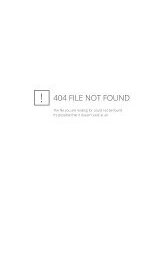GPS May 2020
You also want an ePaper? Increase the reach of your titles
YUMPU automatically turns print PDFs into web optimized ePapers that Google loves.
REMAINING QUESTIONS
The use of the stamps has been known for some time but the ID
cards are very hard to find. From Image 3 we can determine the month
of use, presumably in 1943, of 7 unoverprinted stamps. At first glance,
it appears the months of February through August of 1943 are populated;
however, with a closer look, the handwritten text in the January
space tends to indicate this employee’s service began in June, 1943. This
would make these 7 stamps used from June to December, despite being
placed in the incorrect spaces. Because the top section of the ID card
is in German and the bottom section is in Russian, one can speculate
German or Russian speaking employees were supposed to use the appropriate
section for each months evidence stamp. However, in this case,
as shown in Image 2, because the outside is written in both German and
Russian, it appears this speculation, if true, was not enforced.
Another question involves the number of unused Feldeisenbahn
stamps vs the lack of Feldeisenbahn ID cards, or used stamps, on the
market today. It’s not too difficult, however, to surmise no local civilian
who had been in service to the Germans would want it known to
the Soviets when the East Front moved westward. This would indicate
many of the ID cards were destroyed by employees in an effort not to be
identified as a German collaborator, hopefully avoiding a death sentence.
This could also be the reason why the intended use of the stamps was
not known when the 2002 edition of the Michel Feldpost catalog was
published. This also implies the unused stamps on the market are
remainders, possibly liberated by Soviet troops, the employees themselves,
or other wartime profiteers. Additionally, this would explain why
most of the unused stamps on the market are the overprinted stamps. It
is likely the overprinted stamps were prepared in advance but saw much
less use, if any, as the East Front moved westward in 1944.
The stamps themselves also depart from the typical monthly dues
stamps used by many Nazi organizations. The Feldeisenbahn stamps
are beautifully executed, printed on high quality paper in 12 different
atypical colors with evenly applied vertically ribbed gum. While
no information concerning the printing house is known, it is clear the
product was superior to most other dues stamps printed in Germany.
Many Nazi organizations used the same dues stamp for longer periods
of time together with a date cancel to tie the stamp to a dues receipt
card. Perhaps additional security was necessary in this case enforced by
a color-coding scheme.
May 2020 157





